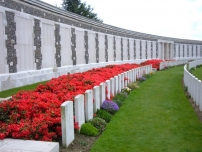| First Name: | Karel | Last Name: | DUSTIR | |
|---|---|---|---|---|
| Date of Death: | 23/09/1917 | Lived/Born In: | Regent's Park | |
| Rank: | Rifleman | Unit: | Rifle Brigade10 | |
| Memorial Site: | Tyne Cot Memorial, Belgium | |||
Current Information:Age-20 Born-Bohemia
Third Battle of Ypres This was a campaign fought between July and November 1917 and is often referred to as the Battle of Passchendaele, a village to the north-east of Ypres which was finally captured in November. It was an attempt by the British to break out of the Ypres salient and capture the higher ground to the south and the east from which the enemy had been able to dominate the salient. It began well but two important factors weighed against them. First was the weather. The summer of 1917 turned out to be one of the the wettest on record and soon the battlefield was reduced to a morass of mud which made progress very difficult, if not impossible in places. The second was the defensive arrangements of concrete blockhouses and machine gun posts providing inter-locking fire that the Germans had constructed and which were extremely difficult and costly to counter. For 4 months this epic struggle continued by the end of which the salient had been greatly expanded in size but the vital break out had not been achieved. The Battle of the Menin Road Ridge. 20th-25th September, 1917 After the disappointing opening battles of the last day of July and the middle of August, when very little had been gained but at great cost in casualties, a new approach was adopted for the next offensive against the Gheluvelt plateau which began on 20th September and became known as the Battle of the Menin Road. The task was handed over to General Plumer, commander of the Second Army, a more cautious leader who, rather than try to drive as deep as possible into the German line, was an advocate of 'bite and hold' tactics with limited advances of no more than 1,500 yards, based on overwhelming firepower and exhaustive preparation. These new tactics, which were significantly aided by a period of warm, dry weather, worked well and September and early October saw a decisive phase of Third Ypres in which the British gained the upper hand. At the same time that Plumer’s Second Army were hammering away at the German defences on the Gheluvelt plateau, Fifth Army also attacked in the northern part of the Ypres salient and they too made gains. 10th Rifle Brigade of 59 Brigade were in reserve when 20th Division attacked on 20th September on the extreme left of the eight mile front with the objective of establishing a northern flank between the Poelcappelle spur and the Ypres-Staden railway. Another of their objectives on that day was Eagle Trench, a trench that ran between two solid embankments about eight feet high. The attack was only partially successful and the enemy were left holding a portion of it and they would have to be removed if further progress was to be made. This task fell to 10th Rifle Brigade, who, on the night of 21st-22nd September had taken over the whole of the brigade front and who made their attack at 7.00am on 23rd September. The position of the enemy in Eagle Trench was a salient with British troops occupying the trench on either side of them and this meant that a British preliminary artillery was not possible for fear of hitting their own troops. A trench mortar was used instead with bombing squads working their way along both flanks, while at the same time, a larger force launched a frontal attack.. The tactic worked well. The enemy, after a brief resistance, realised the impossibility of their position and either surrendered or, if able to, made their way back to two block houses to the rear of their line. An hour later they attempted a counter attack from here but this was dispersed by British artillery and machine-gun fire. This success did not come without a price. 10th Rifle Brigade suffered a number of casualties, including twenty men who were killed. One of these was Karel Dustir. |
||||
| « Back to Search Results | ||||
| If you think any of the information shown here is incorrect, Click Here to submit your amends and comments | ||||




